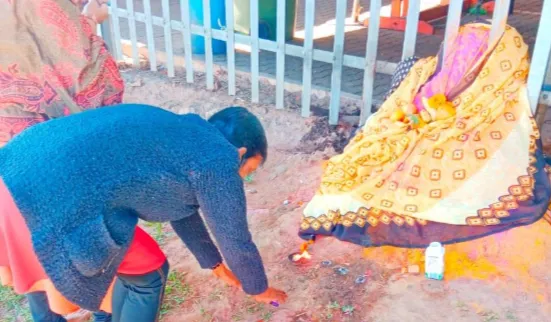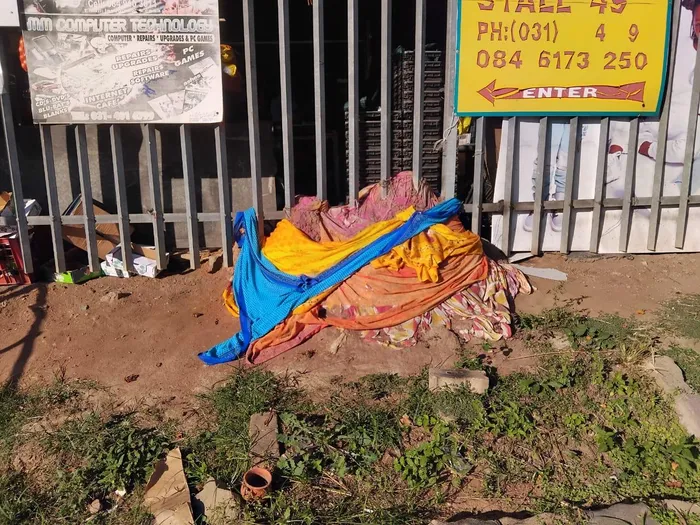Chatsworth market Hindu traders oppose municipality's order to remove sacred puthu
Religious freedom

Community members visit the puthu to pray
Image: Supplied
HINDU stall owners at a Chatsworth market are furious over a notice from the eThekwini Municipality’s instructing them to stop performing rituals at a prayer site and to destroy the puthu (a sacred mound) that was formed at the market in 2022.
The notice, addressed to traders, was issued by the eThekwini Municipality Business Support Tourism and Markets Unit.
It was put up at the entrance of the Fragrance Street Market in Croftdene last Thursday and ordered the stall owners to stop performing rituals at the prayer site and to remove the puthu.
“It has come to our attention that there are traders belonging to a particular conviction who are conducting religious rituals openly at the Fragrance Street Market.

The notice that was put up in the market
Image: Yoshini Perumal
“You are reminded that any religious rituals of any kind are prohibited in public spaces. For any religious ritual to be done in the market as a once-off practice, would need permission from our office.
“Traders belonging to different convictions are therefore requested to refrain from such practice. Should there be any ritual sculptures of some kind placed openly in the market, please remove them immediately,” the notice read.
Keith Pillay, provincial representative of the South African Informal Traders Forum, said the matter was referred to their legal team, who were in the process of engaging with the municipality.
“We are concerned about the call from the municipality for the removal of what they referred to as ‘ritual sculptures’ from the Fragrance Street Market.
“The puthu will not be removed at this stage. The matter has been referred to our legal team, who are preparing a formal response to the municipality. We do not support their blanket approach to religious expression in public spaces,” he added.
Pillay said while the Constitution guaranteed the right to freedom of religion, belief, and cultural practice, any attempt to suppress these rights must be approached with caution.
“Suppressing the rights of people, especially when directed at specific communities or belief systems, must be approached with extreme caution and must pass constitutional muster.
“The notice appears to unfairly target traders of a particular faith and lacks both procedural fairness and a legal foundation. As such, we believe it raises serious questions about compliance with constitutional principles, including equality, religious freedom, and just administrative action.
“We remain committed to resolving the matter lawfully and respectfully, and we call on the municipality to engage in constructive dialogue with affected traders and communities rather than impose unilateral restrictions,” Pillay added.
Kusturi Govender, a fruit and vegetable vendor at the market, said the puthu had formed at the stall she traded from.
“The puthu is visited by members of the public and the stall owners, who take care of it. When people are sick, they visit the puthu and offer saris and prayers.
“We hosted porridge prayers at the puthu with permission from the market supervisor for the last two years, and next month would have been the third porridge prayer. We cook the food in the market and the prayer is funded by stall owners. People from all around Chatsworth attend. But we are now in limbo and do not think we would be allowed to go ahead with the prayer,” she added.

The puthu was destroyed in 2022 but formed again at the same spot.
Image: Yoshini Perumal
Govender said when the puthu was formed in 2022, a cleaner removed it after receiving a directive from the city, but the puthu formed again. It was bigger than the one which was removed, she claimed.
A stall owner, who did not want to be named for fear of victimisation, said there was no religious tolerance and some stall owners were spreading rumours.
“Some people have said that we are worshiping an anthill. They do not believe it is a puthu. Others have spread rumours that since the puthu was formed, their businesses were not doing well. People are not respectful of other religions,” she said.
Another stall owner, who also did not want to be named, said the municipality was bringing division in religion.
“We cannot be expected to destroy the puthu. It is a sacred site. When the cleaner removed the puthu in 2022, she was sick for a week, and her hands bent inward. We know that people who are tasked to destroy sacred spaces would face the consequences, so none of us would attempt to destroy the puthu,” he said.
Pundit Lokesh Maharajh, chairperson of the Priest’s Council for the South African Hindu Maha Sabha, said a puthu was more than just an anthill, especially in Hindu tradition, and particularly among South Indian Tamil communities.
“We are deeply concerned that the notice was issued without prior consultation. It undermines the spiritual rights of our community and disregards the sacredness of the puthu that has emerged and been revered by stall owners since 2022. We urge the municipality to recognise this sacred site, halt any action that may lead to its desecration, and engage in meaningful dialogue with stakeholders to find a respectful and inclusive solution,” he added.
Maharajh said a puthu was a sacred place where divine beings, especially snake deities known as Naga Devata, are believed to live.
“These mounds often form naturally in the ground, but once people recognise their spiritual energy, they become places of worship.
“Devotees may light camphor, pour milk, and offer flowers or turmeric as signs of respect and devotion. The puthu becomes a kind of natural shrine open to the sky, but deeply connected to the earth and unseen spiritual forces. Many also believe that puthu have links to ancestors or earth spirits, and that they help protect communities, bring fertility, and ensure good fortune,” he explained.
Maharaj said because of the deep spiritual meaning, damaging or destroying a puthu was seen as a serious offence.
“People believe that harming it could lead to illness, bad luck, or even a form of divine punishment. This is not seen as superstition, but as a reminder that sacred spaces deserve respect, whether they are inside temples or part of the natural world.
“A puthu may look like an ordinary anthill to someone unfamiliar with Hindu traditions. It is usually a small mound of soil or sand, often shaped like a cone or dome, with tiny holes made by ants or termites. At first glance, it might seem like something to get rid of because it could be a pest problem. A puthu is a sacred shrine. Devotees decorate it with bright vermilion powder (kumkum), turmeric, fresh flowers, and even place small idols, often of snakes, which are deeply respected in Hindu culture. Tiny lamps or trays with burning camphor are used during prayer rituals and the puthu is covered with saris,” Maharaj added.
He said in 2022, when the puthu formed at the market, some people saw it as an ant hill, and a municipal cleaner was reportedly asked to remove it, possibly following city rules against religious structures in public places.
“The cleaner did as instructed and destroyed the mound. Shortly afterwards, the cleaner reportedly became sick, and for many in the Hindu community, this was no coincidence.
“They believed the illness was a sign of divine punishment for disturbing something sacred. Even more striking to them was what happened next: the puthu grew back and this time, it was even larger. To the worshippers, this was not just nature taking its course, but a powerful message that the puthu was meant to be there.
“Stories about people becoming sick if they destroy sacred places are deeply rooted in Hindu tradition, where sacred places are believed to protect themselves, and those who disrespect them are thought to suffer the consequences,” he added.
Maharajh said there were similar age-old stories about people dying after they were tasked to destroy the Shree Gengaiamman Temple in Cato Manor, about 100 years ago.
“According to stories passed down over the years, there have been troubling incidents involving those who tried to damage the temple or take over the land it stands on.
“It was said that those who attempted to destroy or interfere with the temple ended up facing serious misfortunes, with some falling ill and others dying under mysterious circumstances.
“While there may not be official records to prove these events, these stories are widely believed in the community. They serve as a strong warning and a reminder that sacred places should be respected, not disturbed,” Maharajh added.